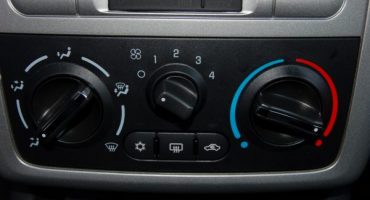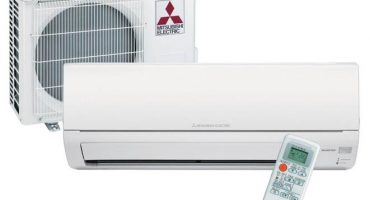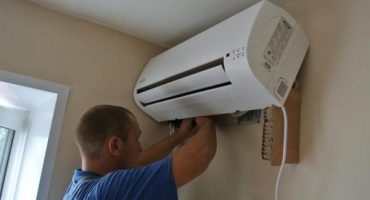Air conditioners need to be refilled regularly - this will ensure stable operation of the equipment. This is done not only in case of equipment breakdown, but also immediately after installation - however, after installation of the climate control system, refueling is usually carried out by masters.
The main rule - you need to refuel the equipment after the rest of the freon has been removed.
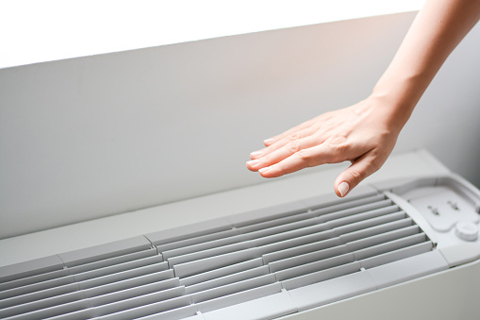
Air conditioner operation
What should be charged with air conditioning and how much substance will be required
Like refrigerators, air conditioners are filled with freon, but freon in the air conditioner uses a special one, designed only for this type of equipment. Commonly used type stamps.
Most often, 2 types of freon are used to refuel the air conditioner:
- R-22 is a reliable refrigerant with high cooling efficiency, which compares it favorably with other types. When using this type of substance, energy consumption increases, but the air conditioner starts to work and cool the room faster. Also, its substitute is suitable - R407c. This type of refrigerant contains chlorine.
- R-134 a is a new type of freon that does not harm the environment, does not contain impurities and is also characterized by high cooling efficiency. However, its cost is high, so this refrigerant is rarely used. This type of freon is often used to refuel a car.
- R-410A - ozone-safe freon.
The following refueling methods are available:
- Fueling by weight. In this case, you need to weigh the cylinder with freon and calculate the required amount, which should get into the system for normal operation of the air conditioner. But this will require the use of special scales, as well as vacuuming inside the equipment.
- Pressure filling This requires a manometric manifold. In this case, you need to know the technical features indicated in the equipment passport, and freon is administered in small portions to control the filling process of the equipment.
There is another way - refueling through a temperature difference, but it is carried out only by professionals.
After installing the equipment, manufacturers usually charge the device based on the standard length of the flow path, the amount of refrigerant needed is usually indicated in the technical documentation of each air conditioner. The data plate is usually located on the case of the external unit or on the protective casing of the air conditioner.
The exact amount of freon is not necessary to calculate, it is enough to know the approximate value. For example, the average length of the route is from 3 to 5 m, and when refueling equipment with a capacity of up to 2 kW, it will be necessary to use about 90 grams of refrigerant. If the power of the device is 8-10 kW, about 600 g of freon will be required.
Important! If the flow path is longer, then for each meter of its length should be added 15 grams of refrigerant.
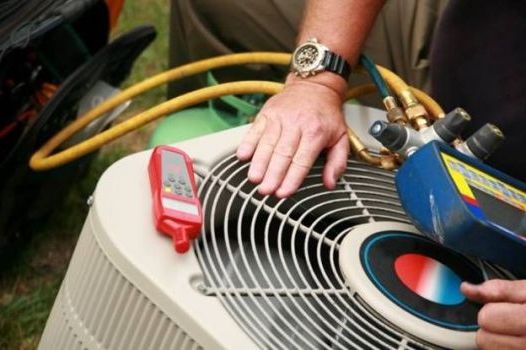
Freon air conditioning
When refueling is required
Air conditioning, which ended in freon, will not be able to work effectively. This is easy to notice - the more time it takes for cooling, the less freon is left in the device. The reasons for the loss of functionality of the split system are pollution of filters, components or other elements, as well as leakage of refrigerant, which most likely leaks through the connections. In this case, the air conditioner needs repair, and then it will be refilled. Otherwise, the refrigerant will continue to leak.
Typically, household air conditioners need refueling 1 time, immediately after installation. Further, they will already need refueling, which can be carried out independently. First you need to determine how much freon is in the air conditioner at the moment, since an insufficient amount of liquid will not save the problem, and excess can lead to breakdown of the equipment.
Preparing the air conditioner for refueling
Before carrying out work, it is necessary to check the system and carefully study the sequence of actions so that refueling the air conditioner yourself, with your own hands, is simple and safe. The split system should be checked for damage and reasons for refrigerant leakage.
Read the step-by-step instructions and prepare special equipment and material for refueling. The type of freon can be found in the technical documentation for the air conditioner, we recommend using 410 refrigerant, but its cost is high and this option is not suitable for everyone. You can also clarify the class of freon from the seller of air conditioning.
Preparation for refueling includes:
- Search for the necessary equipment. A vacuum pump with a pressure gauge and a check valve is required in order to prevent oil from entering the freon system. Typically, such equipment can be rented, it is cheaper than calling craftsmen, but there is no need to purchase it.
- Studying evaporative and condenser tubes, checking the integrity of the freon path.
- Inspect the system and check for leaks. To do this, it is necessary to pump nitrogen into it through a gearbox with a manometer. Nitrogen must be in a gaseous state. The amount of nitrogen is easy to determine - it will cease to enter the system when it is full. Keep track of the pressure gauge, so you can understand if the pressure drops. If it does not fall, then the system is complete and there is no leakage, which means that for normal operation of the air conditioner, you just need to refuel it.
- After this, vacuum is carried out, for it a collector and a vacuum pump will be required. Turn on the pump and when the needle on the pressure gauge reaches the minimum value, turn it off and close the gas valve.
Important! After evacuation do not disconnect the collector from the air conditioner!
Step-by-step instructions for refueling the air conditioner yourself
The following equipment will be required for work:
- Digital scales.
- Digital thermometers.
- A set of keys with 6 faces.
- Manometric manifold. A two or four position type can be used.

Pressure gauge
It is preferable to use a four-position collector type, since when working with a two-position, it will be necessary to reconnect the device due to the formation of an air plug. The four-position collector is completely tight, so there is no contact with air during operation.
Procedure:
- The first stage: the release of freon. Open the locks that are in the service nipples and release the old freon. When all the gas comes out, the locks must be closed.
- The second stage: preparation of the cylinder with freon. The cylinder must be put on the balance, set the balance to zero, then quickly open the valve on it and at the same time open the liquid valve on the manifold to release excess air from the hose.
- The third stage: preparing the air conditioner. The air conditioner is set at a temperature of 18 degrees, the equipment works for cooling. Now the manometer is connected: on the technique you need to find the largest tube that leaves the external unit, unscrew it and attach the manometer to this place. The other end of the pressure gauge is attached to the cylinder with freon.
- Fourth stage: a gas valve is opened on the manifold. During refueling, the system will increase pressure, and the temperature on the thermometer will drop. It is necessary that the pressure rises to an indicator of 5-8 bar.
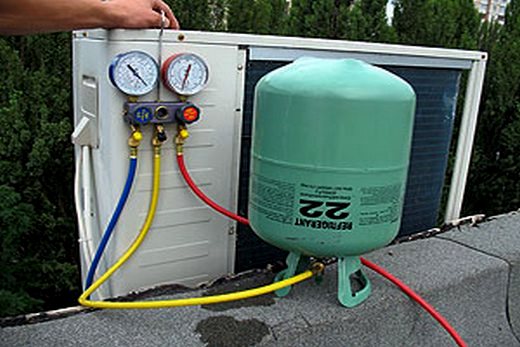
Freon air conditioning
Next, the gas valve is closed, and then the valve is closed on a cylinder with a refrigerant.To find out how much freon was needed to refuel the air conditioner, you should again put the bottle on the scale.
The final stage of work is checking the functionality of the air conditioner.
How to work with freon: precautions
Subject to the rules, there is no danger in working with freon. You can refill the air conditioner at home by following the instructions, and with the right approach, the process will be safe.
Remember, that:
- At a temperature of 400 degrees, the refrigerant decomposes and releases hydrogen chloride and phosgene.
- Chlorine-containing refrigerant brands can cause mucosal irritation and harm the body as a whole.
- If a large amount of substance gets into the air, a person can be poisoned by gases.
- If liquid freon gets on the skin, it will cause frostbite on the skin.
To protect yourself during the work it is recommended:
- Wear cloth gloves and safety glasses - freon in the eyes causes eye damage.
- Check the tightness of the system and valves.
- Do not work indoors.
If the refrigerant gets on the skin or mucous membrane, immediately rinse the area with water and treat with petroleum jelly. If a person has signs of suffocation or poisoning, it is necessary to take him to fresh air and let him breathe oxygen for 30-40 minutes, after which the symptoms will disappear.
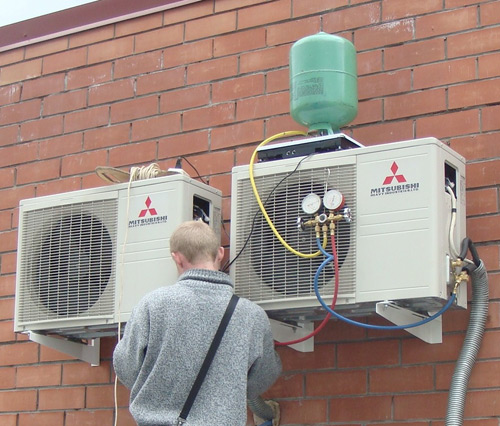
Repair and refueling of air conditioners
How often do I need to refuel an air conditioner
If the equipment is in good condition, integrity is not broken, then refrigerant leakage should not occur. In this case, refueling the air conditioner at home is required every 2-3 years.
If the design is damaged and freon is leaking, you must first repair the equipment, drain the freon, and then refuel the air conditioner. The cause of such a leak may be improper installation of the device, its damage during transportation or too tight fit of the tubes to each other. Sometimes air conditioning pumps freon, and it leaks through pipes inside the equipment.
It is easy to feel the leak of freon: the device will be accompanied by an unpleasant smell of gas, the room will cool very slowly, and frost will appear on the outside of the unit.
Before starting work, we recommend watching thematic videos to avoid mistakes and problems during the work:
Self-filling the air conditioner with freon will help to save a lot of money - the cost of such work by specialists is quite high.

